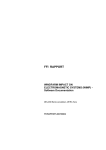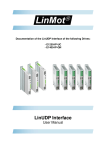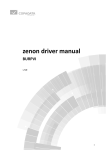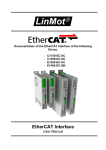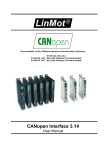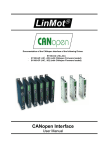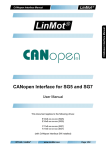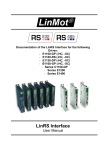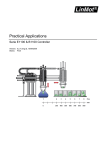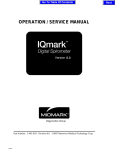Download LinMot Drive Configuration over Fieldbus Interfaces SG5 1.0
Transcript
LinMot Drive Configuration over Fieldbus Interfaces SG5 1.0 User Manual This document applies to the following drives series: A1100 / C1100 C1200 /E1200 E1400 LinMot User Manual LinMot User Manual © 2014 NTI AG This work is protected by copyright. Under the copyright laws, this publication may not be reproduced or transmitted in any form, electronic or mechanical, including photocopying, recording, microfilm, storing in an information retrieval system, not even for didactical use, or translating, in whole or in part, without the prior written consent of NTI AG. LinMot® is a registered trademark of NTI AG. The information in this documentation reflects the stage of development at the time of press and is therefore without obligation. NTI AG reserves itself the right to make changes at any time and without notice to reflect further technical advance or product improvement. Document version 1.2 / Whp/Ro, May 2014 NTI AG / LinMot® www.LinMot.com Page 2/35 LinMot User Manual 1 Introduction......................................................................................................................5 2 Firmware Parameters......................................................................................................6 2.1 Overview.....................................................................................................................6 2.2 Unique Parameter ID and Raw Data Value................................................................7 2.3 ROM and RAM Value.................................................................................................7 2.4 Default Value...............................................................................................................8 2.5 32 Bit Access for any Parameter Type.......................................................................9 3 Firmware Layer Concept...............................................................................................10 4 Parameter Configuration Compatibility Rules............................................................12 5 Curves.............................................................................................................................13 5.1 Curve Object.............................................................................................................14 5.2 Curve Info Block.......................................................................................................15 5.2.1 Data Offset........................................................................................................15 5.2.2 Object Type.......................................................................................................15 5.2.3 Number of Setpoints..........................................................................................15 5.2.4 Data Type Size..................................................................................................15 5.2.5 Name.................................................................................................................16 5.2.6 Curve ID............................................................................................................16 5.2.7 X-Length............................................................................................................16 5.2.8 X/Y-Dimension UUID.........................................................................................16 5.2.9 Wizard Information............................................................................................16 5.3 Curve Data Block......................................................................................................17 5.4 Erasing all curves from the Drive's RAM..................................................................17 5.5 Uploading Curves from the Drive.............................................................................18 5.6 Downloading Curves into the Drive's RAM...............................................................19 6 Command Table.............................................................................................................20 6.1 Command Table Entry Format..................................................................................21 7 Real Time IO Configuration Module.............................................................................22 7.1 Configuration Module Control...................................................................................22 7.1.1 Command Count...............................................................................................22 7.1.2 Parameter Command ID...................................................................................23 7.2 Configuration Module Status....................................................................................25 7.2.1 Overview Configuration Module Return Status Values.....................................25 7.2.1.1 Overview Parameter access......................................................................26 7.2.1.2 Overview Curve access.............................................................................26 7.2.1.3 Start getting UPID List...............................................................................26 7.2.1.4 Get next UPID List item.............................................................................27 7.2.1.5 Start getting Modified UPID List (Command ID 22h).................................28 7.2.1.6 Get Next Modified UPID List Item (Command ID 23h)..............................28 7.2.1.7 Get Error Log Entry Counter (Command ID 70h)......................................28 7.2.1.8 Get Error Log Entry Error Code (Command ID 71h).................................28 7.2.1.9 Get Error Log Entry Time Low (Command ID 72h)...................................28 7.2.1.10 Get Error Log Entry Time High (Command ID 73h).................................29 7.2.1.11 Get Error Code Text Stringlet (Command ID 74h)...................................29 7.2.1.12 Command Table: Save To Flash (Command ID 80h)..............................29 7.2.1.13 Command Table: Delete All Entries (RAM) (Command ID 81h).............29 7.2.1.14 Command Table: Delete Entry (Command ID 82h).................................30 7.2.1.15 Command Table: Write Entry (Command ID 83h)...................................30 NTI AG / LinMot® www.LinMot.com Page 3/35 LinMot User Manual Table of Content LinMot User Manual LinMot User Manual 7.2.1.16 Command Table: Write Entry Data (Command ID 84h)..........................30 7.2.1.17 Command Table: Get Entry (Command ID 85h)......................................30 7.2.1.18 Command Table: Get Entry Data (Command ID 86h).............................30 7.2.1.19 Command Table: Get Entry List (0..7) (Command IDs 87h .. 8Eh)........31 8 PVL Data Format............................................................................................................32 9 Contact Addresses........................................................................................................35 NTI AG / LinMot® www.LinMot.com Page 4/35 LinMot User Manual 1 Introduction Most of the LinMot drives are equipped with a fieldbus interface to the superior control system (PLC, IPC). This interface is used for controlling the drive under normal operation conditions (read/write of control and status word, sending motion commands, etc.). If the LinMot drive uses a fieldbus connection for the communication to the superior control system (PLC, IPC), then the same fieldbus interface can be used for configuration purposes via PLC as well. The following fieldbus interfaces are supported: PROFINET, EtherCAT, sercos, POWERLINK, EtherNet/IP, Profibus DP, CANOpen, DeviceNet, RS232 and RS485 (using LinRS protocol). This document describes in general the access to the configuration parameters and the curve data over fieldbus interfaces. Detailed information about how data access is implemented in the respective interfaces can be found in the corresponding interface user manuals. NOTE: The drive series A1100, C1100, C1200, E1200 and E1400 differ in some functions from each other. If nothing is indicated, the behavior is the same. NTI AG / LinMot® www.LinMot.com Page 5/35 LinMot User Manual Users of LinMot drives can easily setup their drive by using the LinMot-Talk software. Beside other functionality (firmware download, monitoring, PLC emulation, etc.), the LinMot-Talk software is used for altering the firmware configuration parameters, for creating and up- and downloading of curve profiles. LinMot User Manual 2 Firmware Parameters The LinMot drive firmware has to be configured through its parameters in order to meet the needs of the application where the servo system has to be integrated. Typical examples of firmware parameters that must be set during the commissioning process are motor definition parameters, position control parameters, etc. The easiest way to alter parameters is to use the LinMot-Talk software tool. The software displays the parameters in a comfortable tree structure. Most of the parameters are displayed as a scaled value with the corresponding physical unit. Figure 1: Firmware parameters listed in a tree structure NTI AG / LinMot® www.LinMot.com Page 6/35 LinMot User Manual 2.1 Overview LinMot User Manual 2.2 Unique Parameter ID and Raw Data Value Both, UPID and raw data value of any parameter can be displayed in the LinMotTalk parameter tree structure (press Show/Hide Details button). Show/Hide Details button raw data value Unique Parameter ID number Figure 2: Detailed view for parameters 2.3 ROM and RAM Value The value of any parameter is stored in the non-volatile memory area of the LinMot drive (ROM value). During the boot-up process the drive’s operating system creates a copy of the non-volatile memory block to its RAM memory space. Thus, after the drive has powered up, each parameter has two memory locations and values: one in the ROM, the other in the RAM. The firmware uses at run time exclusively the RAM values of the parameters in its control tasks (fast data access). The drive’s operating system and the fieldbus interfaces provide independent access to ROM and RAM values. When parameters are altered using the LinMot-Talk software, the ROM and/or the RAM value are affected: - When ‘live’ parameters are changed, then the LinMot-Talk4 software writes to ROM and RAM memory. NTI AG / LinMot® www.LinMot.com Page 7/35 LinMot User Manual The value of any parameter is stored as an integer value (raw data) in the memory space of the drive. The parameter is identified through its Unique Parameter ID (UPID), which is a 16 Bit integer number. LinMot User Manual - ‘Non-Live’ parameters are written only to ROM (and are copied to RAM at next firmware start). Over the fieldbus interface the RAM value of ‘non-live’ parameters cannot be changed. Changing the ROM value is possible even when the firmware is running (except for read-only parameters). Changing the RAM value of a parameter immediately influences the system behavior when the firmware is running (e.g. control parameters of the position control loop). The RAM value of live parameters (marked with a superscript ‘L’) can be altered at run time. Figure 3: Live Parameters marked with a superscript 'L' Changes to ROM values don’t affect the system behavior until the next firmware startup (e.g. after a software reset initiated by the superior control system or stop/start from the LinMot-Talk software). 2.4 Default Value Beside the actual RAM and ROM value each parameter has its default value. The default value is displayed in the detailed parameter view of the LinMot-Talk software. During firmware installation the ROM values are set to the default values of the corresponding parameters. E1200 and E1400 drives provide resetting the parameters to their default values over fieldbus interfaces. Resetting to default value is possible for single parameters (via UPID) or for all parameters of any firmware layer at once (see below). NTI AG / LinMot® www.LinMot.com Page 8/35 LinMot User Manual The LinMot-Talk software reads and displays the ROM values. It reads the parameter values only once (during the login process). The PC software allows altering ‘non-live’ parameters only if the firmware is stopped. LinMot User Manual 2.5 32 Bit Access for any Parameter Type Since string parameters can be longer than 4 characters (= 4 Bytes), a single 32bit integer value is not sufficient to define a general string. Therefore strings are handled in a special way: • In the LinMot-Talk software to each string parameter one single UPID is shown. • Internally the string is split into parts (so called ‘stringlets’) of 4 characters (= 4 bytes = 32 bits). • Each stringlet has its own UPID. • The UPID of the first stringlet is the string UPID plus 1, the UPID of the second stringlet is the string UPID plus 2 and so on. The following example shows the principle of converting strings to raw data values. Example: Writing the string ‘X-Axis Left’ to the parameter ‘User Comment’: Figure 4: String parameter example for E1200 (see UPID 03F2h) The following table shows how the stringlet UPIDs and the corresponding 32bit integer values are determined: Stringlet "X Ax" “is L” “eft” Parameter UPID 03F3h 03F4h 03F5h Ordinal 1st Char: Ord(‘X’)=58h Ord(‘i’)=69h Ord(‘e’)=65h Ordinal 2nd Char: Ord(‘ ‘)=20h Ord(‘s‘)=73h Ord(‘f‘)=66h Ordinal 3rd Char: Ord(‘A’)=41h Ord(‘ ’)=20h Ord(‘t’)=74h Ordinal 4th Char: Ord(‘x’)=78h Ord(‘L’)=4Ch 00h Parameter Value: 78412058h 4C207369h 00746665h Table 1: String access over stringlets NTI AG / LinMot® www.LinMot.com Page 9/35 LinMot User Manual The whole configuration consists of parameters of different types (bit, byte, 16bit integer, 32bit integer and string parameters). In order to keep the interface as simple as possible any parameter can be accessed as a 32bit integer value. The drive’s operating system will filter out the relevant number of bits for each parameter. LinMot User Manual 3 Firmware Layer Concept Layer Name Layer Functionality 1 Operating System - Resource Management - Communication with LinMot-Talk - Start/Stop of the other SW layers - Parameter / Variable Service - Oscilloscope Service - Message / Error Service 2 Motion Control Software - Current Control Loop - Position Control Loop - Set Value Generation - Monitoring 3 Interface Software - Communication to superior control system (e.g. via PROFINET; EtherNet/IP, Profibus, CANOpen, DeviceNet, LinRS, etc.) 4 Application - Customized firmware extensions Table 2: The four firmware layers Each firmware part has its own parameters located in a separate branch of the parameter tree. Figure 5: Parameter tree with branches for the different firmware layers On SG5 drives, each firmware layer has its own range of UPIDs for its parameters and variables. Layer Name UPID Range 1 Operating System 0000h…0EFFh 2 Motion Control SW 1000h…1EFFh 3 Interface Software 2000h…2EFFh 4 Application 3000h…3EFFh Table 3: UPID value ranges for SG5 drives. The parameter definitions are stored in the drive. On SG5 drives the UPID, RAM/ROM locations, default values, parameter type, min/max values and access rights are stored. The corresponding definition files have been downloaded together NTI AG / LinMot® www.LinMot.com Page 10/35 LinMot User Manual The firmware on the drive consists of up to four layers: LinMot User Manual Figure 6: Parameter tree information The parameter subtree (e.g. Profibus parameter tree V3.0 etc.) is defined through its Tree ID, Main Version and Subversion value. This information can be captured by reading out the values of the parameters with UPID according to the following table. These parameters are used to perform compatibility tests before parameter configurations are downloaded to drives (see below). Layer Tree ID UPID Main Version UPID Sub Version UPID 1 OS 0539h 0532h 0533h 2 MC SW 0561h 055Ah 055Bh 3 Interface SW 0589h 0582h 0583h 4 Application 05B1h 05AAh 05ABh Table 4: UPID value of tree identification of the different SW layers NTI AG / LinMot® www.LinMot.com Page 11/35 LinMot User Manual with the firmware when the firmware was installed on the drive. Information about the currently installed parameter tree files can be found in the operating system parameter tree branch. LinMot User Manual 4 Parameter Configuration Compatibility Rules Besides the parameters raw data the PVL file contains additional information about the system on which the PVL file was created. Before complete parameter configurations are downloaded from the superior machine control system to the LinMot drive, it is recommended to perform some compatibility checks. With these checks it can be ensured, that the configuration stored in the superior control system (source file) is fully compatible with the firmware installed drive (target system). The following rules must be considered for each firmware layer: Check Value Rule Tree ID Tree ID of the source file and target system must be the same (e.g. it is not possible to download a DeviceNet setup onto a drive with Profibus interface firmware installed). Tree Main Version The source file parameter tree must have the same Main Version as the tree installed on the target system. Tree Sub Version The Sub Version of the source must be the same or smaller than the corresponding value of the target system (backward compatibility within main version). Table 5: Compatibility Rules for SG5 drives NTI AG / LinMot® www.LinMot.com Page 12/35 LinMot User Manual The current parameter configuration can be stored into a PVL file. This text file contains the parameter UPID and value in an easy to interpret list. This parameter list can easily be stored in a superior machine controller (PLC, IPC) and downloaded to any drive of the same type if necessary. LinMot User Manual 5 Curves LinMot User Manual The drives can store up to 100 curves, which can be generated and downloaded by the LinMot-Talk Software. The curves are identified by their ID (1..100). y dimension (typically position) x dimension (typically time) Figure 7: Curves within LinMot-Talk The curves, which can be accessed by the motion control firmware through corresponding motion commands, are located in the RAM memory space of the drive. They can be permanently stored into a flash memory block as well. At boot time the operating system copies the curve data from the flash memory to the RAM memory block. The curve profiles, which are generated and downloaded using the LinMot-Talk software, are always stored to RAM and flash memory (permanently saved). It is also possible to download curves to the drive over the fieldbus. Then it is necessary to have the curve objects stored in the superior machine drive. There are three ways to bring the profiles there: 1. The curves are created and downloaded to a drive with LinMot-Talk. Then the curve objects can be uploaded from the drive over the fieldbus interface (using the curve service). 2. The curves are created and then exported to a raw data file (PVL file) using the LinMot-Talk software. Then the PVL file can be loaded to the main drive. 3. The curve object is fully generated by the main machine controller without using the LinMot-Talk curve tool. NTI AG / LinMot® www.LinMot.com Page 13/35 LinMot User Manual 5.1 Curve Object Each curve object consists of a curve info block (header) and a curve data block (setpoints). The curve service provides commands for reading/writing these blocks. For further details how the curve service is implemented in the various fieldbus interfaces please consult the corresponding interface manuals. Byte Off Type Name 0..1 UInt16 Data offset 2..3 UInt16 Object type 4..5 UInt16 Number of setpoints 6..7 UInt16 Data Type size 8..29 String Name 30..31 UInt16 Curve ID 32..35 UInt32 x-Length 36..37 UInt16 XDimUUID 38..39 UInt16 YDimUUID 40..41 UInt16 Wizard Type 42..45 UInt32 Wizard Par 1 46..49 UInt32 Wizard Par 2 50..53 UInt32 Wizard Par 3 54..57 UInt32 Wizard Par 4 58..61 UInt32 Wizard Par 5 62..65 UInt32 Wizard Par 6 66..69 UInt32 Wizard Par 7 Curve Data Block 0..xxx Curve Setpoints Table 6: Curve Object: Info Block and Data Block NTI AG / LinMot® www.LinMot.com Page 14/35 LinMot User Manual Curve Info Block LinMot User Manual 5.2 Curve Info Block The Data Offset contains the info block size information. The software expects the info block to consist of 70 bytes. So the first word of the info block must have the value 70 (= 46h). 5.2.2 Object Type The Object Type word consists of four nibbles (1 nibble = 4 bits): • lowest nibble: Object Version (must be 3) • lower middle nibble: Type of Object (Curve = 0h) • higher middle nibble: X dimension Code • highest nibble: Y dimension Code Curve Info Block: Object Type Byte Name Bit Bit Bit Bit 7 6 5 4 0 Type & Version Type of Object: 0h (=Curve) 1 X&Y Y dimension code: dimension codes 0: Position 1: Velocity 2: Current 3: Encoder Pos (Increments) 4: Encoder Speed 5: MicroSteps Bit Bit Bit Bit 0 3 2 1 Version: 3h (=SWVersion 3.x) X dimension code: 0: Time 1: Encoder Pos (Increments) 2: Position Table 7 Curve Info Block: Object Type According to the definitions above the Object Type has the following value: • Position vs. Time curve: 0003h • Cam profiles (Pos vs. Enc. Pos.): 0103h Other object types are not supported yet. 5.2.3 Number of Setpoints The number of setpoints of the profile is given as 16bit value. The minimal number of setpoints is 2. 5.2.4 Data Type Size This value defines the size of one setpoint. Position values are defined in 32bit format (32bit = 4 bytes). NTI AG / LinMot® www.LinMot.com Page 15/35 LinMot User Manual 5.2.1 Data Offset LinMot User Manual 5.2.5 Name If the profile is machine generated (PLC-Program, etc.), the name space will be typically filled with 00h. 5.2.6 Curve ID The Curve ID must be unique. Allowed values are : 1..100 (0001h..0064h). 5.2.7 X-Length The X-Length defines the base length of the curve profile. • Position vs. Time Curve : Time [10us] • Cam profiles (Pos vs. Enc. Pos.) : Encoder Pos [Increments] 5.2.8 X/Y-Dimension UUID The following Unique Unit IDs (UUIDs) are supported: Unit Definition UUID 0005h 001Ah 001Bh Unit Scaling 0.1 um (=1*10-7m) 0.01 ms (=1*10-5s) 1 Increment Description Standard Linear Position Unit Standard Curve Time Unit Standard Encoder Position Unit Table 8: Unit Definitions According to the table above the following values are correct: Position vs. Time Curves : XDimUUID = 001Ah YDimUUID = 0005h Cam Profiles : XDimUUID = 001Bh YDimUUID = 0005h 5.2.9 Wizard Information The wizard information (wizard type & wizard parameters) is used only by the LinMot-Talk software. All those bytes should be set to 0x00 for curves which are not generated with the LinMot-Talk curve tool. NTI AG / LinMot® www.LinMot.com Page 16/35 LinMot User Manual In order to make identification easier, a descriptive name can be defined (e.g. ‘Fast Move Out’ or ‘Retraction’). 22 bytes are reserved for the name string. The string is terminated with 00h. LinMot User Manual 5.3 Curve Data Block The curve data block contains the setpoints (Y-dimension). The size of the block is: No Of Setpoints * Data Type Size 5.4 Erasing all curves from the Drive's RAM All curves in the RAM of the drive can be deleted by the following command: • Curve Service: Delete all Curves (RAM) NTI AG / LinMot® www.LinMot.com Page 17/35 LinMot User Manual The setpoints are equally spaced over the x-length. The x-dimension equidistance is: x-Length / (No Of Setpoints – 1). LinMot User Manual 5.5 Uploading Curves from the Drive • Curve Service: Get Curve • Curve Service: Get Curve Info Block • Curve Service: Get Curve Data The curve service commands are described in the corresponding interface manuals. Reading a curve is according the following scheme: Begin Read Curve x G e t C u rv e : -> x (c u rv e N u m b e r) < - I (In fo B lo c k s iz e ) < - D ( D a t a B lo c k s iz e ) NO OK? YES G e t C u r v e In fo B lo c k : -> x (c u rv e N u m b e r) < - ( In fo B lo c k D a ta [ x . .y ]) NO OK? YES NO All Info Block Data read? YES G e t C u rv e D a ta B lo c k : -> x (c u rv e N u m b e r) < - (D a ta B lo c k D a ta [x ..y ]) NO OK? YES All Data Block Data read? YES Finished Read Curve x Figure 8: Flowchart Read Curve NTI AG / LinMot® www.LinMot.com Page 18/35 LinMot User Manual To read a curve from the drive using the fieldbus interface, the following commands have to be used: LinMot User Manual 5.6 Downloading Curves into the Drive's RAM • Curve Service: Add Curve • Curve Service: Add Curve Info Block • Curve Service: Add Curve Data LinMot User Manual To write a curve into the RAM of the drive, the following commands have to be used: The writing of a curve is always according to the following scheme: Begin Add Curve x Add Curve: -> x (curve Number) -> I (Info Block size) -> D (Data Block size) NO OK? YES Add Curve Info Block: -> x (curve Number) -> (Info Block Data [x..y]) NO OK? YES NO All Info Block Data written? YES Add Curve Data Block: -> x (curve Number) -> (Data Block Data [x..y]) NO OK? YES All Data Block Data written? YES Finished Add Curve x Figure 9: Flowchart Add Curve NTI AG / LinMot® www.LinMot.com Page 19/35 LinMot User Manual 6 Command Table LinMot User Manual For programming simple sequences with decisions the LinMot drive supports the command table (CT) programming utility. Up to 255 CT entries can be programmed. The entries can be arranged in sequences and some branch possibilities are supported. Figure 10: Command Table within LinMot-Talk The CT entries can be accessed by the motion control firmware through corresponding motion commands or through digital IOs. The firmware uses the table data that is located in the RAM memory space of the drive. The CT can be stored permanently into the flash memory as well. At boot time the operating system copies the entire CT from the flash memory to the RAM. If the CT entries are generated and downloaded using the LinMot-Talk software, they are always stored into RAM and flash memory (permanently saved). It is also possible to download or modify CT entries in the drive over a fieldbus. Then it is necessary to have the CT entry data stored in the superior machine controller. There are three ways to bring the entry data to the LinMot drive: 1. The CT entries are created and downloaded to a drive by using the LinMotTalk software. Afterwards the CT entry data can be uploaded from the drive over the fieldbus interface (using the CT service). 2. The CT entries are created and then exported to a raw data file (PVL file) using the LinMot-Talk software. This generated file can be loaded to the main controller. 3. The CT entry data is fully generated by the main machine controller without using the LinMot-Talk command table editor. NTI AG / LinMot® www.LinMot.com Page 20/35 LinMot User Manual 6.1 Command Table Entry Format LinMot User Manual Each CT entry consists of one bit in a presence list (bit = 0 entry exists) and a command table entry data block of 64 bytes size. The CT service provides commands for reading/writing those blocks. For further details how the CT services can be used for reading and writing CT entries over a fieldbus interface, please consult the corresponding interface manual. Command Table Entry Presence List Byte Off 00h..03h 04h..07h 08h..0Bh 0Ch..0Fh 10h..13h 14h..17h 18h..1Bh 1Ch..1Fh Description Bit field for entries 1..31 (Bit = 0 entry exists) Bit field for entries 32..63 Bit field for entries 64..95 Bit field for entries 96..127 Bit field for entries 128..159 Bit field for entries 160..191 Bit field for entries 192..223 Bit field for entries 224..255 Table 9: Command Table Entry Saving Format Command Table Entry Data Block Byte Off 00h..01h 02h..03h 04h..05h 06h..25h Description Command entry Version ID fix A701h Linked Command Entry ID (ID=FFFFh not linked) Motion Command Header Motion Command Parameters 26h..35h 36h..3Fh Entry Name (0 terminated string with up to 16 characters) Reserved for further use Table 10: Command Table Entry Data Block Format For reading a CT entry, the start reading entry with ID command returns the data block size in bytes (40h). After this command a read command can be repeated until the whole data block is read out. For writing a CT entry, start with a command which defines the ID and the data block size, after this repeat writing the data with a command until the whole data is written. If this is done correctly the bit in the presence list will be cleared. For modifying a single motion command parameter during runtime, a motion command exists, with ID, write offset and data as parameters. NTI AG / LinMot® www.LinMot.com Page 21/35 LinMot User Manual The Configuration Module module allows access to parameters, variables, curves, error log and command table. Also restart, start and stop of the drive is possible. Of course the Configuration Module module works independently from the MC Interface. For this reason changing a parameter and sending a motion command can be done in parallel. Word DO DI 1. 2. Configuration Module Control Argument (meaning depends on Cmd ID) Argument (meaning depends on Cmd ID) Argument (meaning depends on Cmd ID) Configuration Module Status Argument (meaning depends on Cmd ID) 3. 4. Argument (meaning depends on Cmd ID) Argument (meaning depends on Cmd ID) 7.1 Configuration Module Control Parameter Command ID to be executed Reserved 15 7 14 13 12 11 10 9 8 6 Command Count 5 4 3 2 1 0 The Configuration Module Control is split in two parts: • Parameter Command ID to be executed (bits 8-15), see table Command ID • Command Count (bits 0-3) 7.1.1 Command Count A new command is only evaluated, if the value of the command count changes. In the easiest way bit 0 could be toggled. NTI AG / LinMot® www.LinMot.com Page 22/35 LinMot User Manual 7 Real Time IO Configuration Module LinMot User Manual 7.1.2 Parameter Command ID This selects the command. Command ID Description 00h No Operation LinMot User Manual Configuration Module Command ID List: Parameter Access 10h Read ROM Value of Parameter by UPID 11h Read RAM Value of Parameter by UPID 12h Write ROM Value of Parameter by UPID 13h Write RAM Value of Parameter by UPID 14h Write RAM and ROM Value of Parameter by UPID 15h Get minimal Value of Parameter by UPID 16h Get maximal Value of Parameter by UPID 17h Get default Value of Parameter by UPID Parameter (UPID) List 20h Start Getting UPID List 21h Get next UPID List item 22h Start Getting Modified UPID List 23h Get next Modified UPID List item Stop / Start / Default 30h Restart drive (Recommended with Command Count = 0 !) 31h Set parameter ROM values to default (OS SW) 32h Set parameter ROM values to default (MC SW ) 33h Set parameter ROM values to default (Interface SW) 34h Set parameter ROM values to default (Application SW) 35h Stop MC and Application Software (for Flash access) 36h Start MC and Application Software Curve Service 40h Save all Curves from RAM to Flash 41h Delete all Curves (RAM) 50h Start Adding Curve (RAM) 51h Add Curve Info Block (RAM) 52h Add Curve Data (RAM) 53h Start Modifying Curve (RAM) 54h Modify Curve Info Block (RAM) 55h Modify Curve Data (RAM) 60h Start Getting Curve (RAM) 61h Get Curve Info Block (RAM) 62h Get Curve Data (RAM) NTI AG / LinMot® www.LinMot.com Page 23/35 LinMot User Manual 70h Get Error Log Entry Counter 71h Get Error Log Entry Error Code 72h Get Error Log Entry Time low 73h Get Error Log Entry Time high 74h Get Error Code Text Stringlet LinMot User Manual Error Log Command Table 80h Command Table: Save to Flash 81h Command Table: Delete All Entries (RAM) 82h Command Table: Delete Entry 83h Command Table: Write Entry 84h Command Table: Write Entry Data 85h Command Table: Get Entry 86h Command Table: Get Entry Data 87h Get Presence List of Entries 0..31 from RAM 88h Get Presence List of Entries 32..63 from RAM 89h Get Presence List of Entries 64..95 from RAM 8Ah Get Presence List of Entries 96..127 from RAM 8Bh Get Presence List of Entries 128..159 from RAM 8Ch Get Presence List of Entries 160..191 from RAM 8Dh Get Presence List of Entries 192..223 from RAM 8Eh Get Presence List of Entries 224..255 from RAM NTI AG / LinMot® www.LinMot.com Page 24/35 LinMot User Manual 7.2 Configuration Module Status 15 14 13 12 Reserved 11 10 9 8 7 6 Command Count Response 5 4 3 2 1 0 The Configuration Module Status is split in two parts: • Parameter Status (bits 8-15), see table Parameter Status • Command Count Response (bits 0-3) Echo of Command Count of Control Word for Handshaking 7.2.1 Overview Configuration Module Return Status Values Status Return Value Description 00h OK, done 02h Command Running / Busy 04h Block not finished (Curve Service) 05h Busy C0h UPID Error C1h Parameter Type Error C2h Range Error C3h Address Usage Error C5h Error: Command 21h “Get next UPID List item” was executed without prior execution of “Start Getting UPID List” C6h End of UPID List reached (no next UPID List item found) D0h Odd Address D1h Size Error (Curve Service) D4h Curve already defined / Curve not present (Curve Service) NTI AG / LinMot® www.LinMot.com Page 25/35 LinMot User Manual Parameter Status LinMot User Manual Word DO DI 1. Configuration Module Control Configuration Module Status 2. Parameter UPID Parameter UPID 3. Parameter Value Low Parameter Value Low 4. Parameter Value High Parameter Value High 7.2.1.2 Overview Curve access Word DO DI 1. Configuration Module Control Configuration Module Status 2. Curve Number Curve Number 3. Data Value Low / Info Block size Data Value Low / Info Block size 4. Data Value High / Data Block size Data Value High / Data Block size 7.2.1.3 Start getting UPID List Word DO DI 1. Configuration Module Control Configuration Module Status 2. Start UPID (search from this UPID) - 3. - - 4. - - NTI AG / LinMot® www.LinMot.com Page 26/35 LinMot User Manual 7.2.1.1 Overview Parameter access LinMot User Manual Word DO DI 1. Configuration Module Control Configuration Module Status 2. - UPID found 3. - Address Usage 4. - - 14 13 12 NTI AG / LinMot® 11 10 9 8 7 6 www.LinMot.com 5 4 3 2 RAM Read RAM Write ROM Read Life Parameter Not used for Hash calculation 15 ROM Write Address Usage 1 Page 27/35 0 LinMot User Manual 7.2.1.4 Get next UPID List item LinMot User Manual Word DO DI 1. Configuration Module Control Configuration Module Status 2. Start UPID (search from this UPID) - 3. - - 4. - - 7.2.1.6 Get Next Modified UPID List Item (Command ID 23h) Word DO DI 1. Configuration Module Control Configuration Module Status 2. - UPID found 3. - Data Value Low 4. - Data Value High 7.2.1.7 Get Error Log Entry Counter (Command ID 70h) Word DO DI 1. Configuration Module Control Configuration Module Status 2. - - 3. - Number of Logged Errors 4. - Number of Occurred Errors 7.2.1.8 Get Error Log Entry Error Code (Command ID 71h) Word DO DI 1. Configuration Module Control Configuration Module Status 2. Entry Number (0..24) Entry Number 3. - Logged Error Code 4. - - 7.2.1.9 Get Error Log Entry Time Low (Command ID 72h) Word DO DI 1. Configuration Module Control Configuration Module Status 2. Entry Number (0..24) Entry Number 3. - Entry Time Low Word 4. - Entry Time Mid Low Word NTI AG / LinMot® www.LinMot.com Page 28/35 LinMot User Manual 7.2.1.5 Start getting Modified UPID List (Command ID 22h) LinMot User Manual Get Error Log Entry Time High (Command ID 73h) Word DO DI 1. Configuration Module Control Configuration Module Status 2. Entry Number (0..24) Entry Number 3. - Entry Time Mid High Word 4. - Entry Time High Word The Error Log Entry Time consists of 32Bit hours (Time High) and 32Bit ms (Time Low). 7.2.1.11 Get Error Code Text Stringlet (Command ID 74h) Word DO DI 1. Configuration Module Control Configuration Module Status 2. Error Code Error code 3. Stringlet Number (0..7) Stringlet Byte 0 and 1 4. - Stringlet Byte 2 and 3 7.2.1.12 Word Command Table: Save To Flash (Command ID 80h) DO DI 1. Configuration Module Control Configuration Module Status 2. - - 3. - - 4. - - For this command, the MC software must be stopped (with command “35h: Stop MC and Application Software”). The Fieldbus Interface will stay active while the MC software is stopped. 7.2.1.13 Command Table: Delete All Entries (RAM) (Command ID 81h) Word DO DI 1. Configuration Module Control Configuration Module Status 2. - - 3. - - 4. - - NTI AG / LinMot® www.LinMot.com Page 29/35 LinMot User Manual 7.2.1.10 LinMot User Manual Command Table: Delete Entry (Command ID 82h) Word DO DI 1. Configuration Module Control Configuration Module Status 2. Entry Number Entry Number 3. - - 4. - - 7.2.1.15 Command Table: Write Entry (Command ID 83h) Word DO DI 1. Configuration Module Control Configuration Module Status 2. Entry Number Entry Number 3. Block Size (even number of bytes) Block Size 4. - - 7.2.1.16 Command Table: Write Entry Data (Command ID 84h) Word DO DI 1. Configuration Module Control Configuration Module Status 2. Entry Number Entry Number 3. Data Data 4. Data Data 7.2.1.17 Command Table: Get Entry (Command ID 85h) Word DO DI 1. Configuration Module Control Configuration Module Status 2. Entry Number Entry Number 3. - Block Size 4. - - 7.2.1.18 Command Table: Get Entry Data (Command ID 86h) Word DO DI 1. Configuration Module Control Configuration Module Status 2. Entry Number Entry Number 3. - Data 4. - Data NTI AG / LinMot® www.LinMot.com Page 30/35 LinMot User Manual 7.2.1.14 LinMot User Manual Command Table: Get Entry List (0..7) (Command IDs 87h .. 8Eh) Word DO DI 1. Configuration Module Control Configuration Module Status 2. - Offset in bytes 3. - Bit field (Bit set= undefined / Bit cleared = used) 4. - Bit field (Bit set= undefined / Bit cleared = used) NTI AG / LinMot® www.LinMot.com Page 31/35 LinMot User Manual 7.2.1.19 LinMot User Manual The parameter settings, curve profiles and command table of a LinMot drive can be exported together with other data (parameters, oscilloscope settings) as a configuration file (ending *.lmc) with the LinMot-Talk software. The configuration file can then be imported to other drives again under usage of the LinMot- Talk software. Some users of the LinMot drives want to store the parameter setup and/or curves in their main machine controller (PLC, IPC) as a simple value list. So they don’t need any PC tools for configuration of drives when they produce series of the same machine type or when they have to replace a drive in the plant. Beside the possibility of exporting configurations in LMC file format the LinMot- Talk software allows to save the setup into a simple text file. Data is stored in an easy interpretable comma separated value format. The file has the extension *.pvl (Parameter Value List). A simple parser can convert the text file data into the customer specific data format. Figure 11: Export Raw Data The LinMot-Talk software offers selective export of configuration data: If ‘All Parameters’ is selected, all parameters are listed in the export file (hundreds of parameters, most of them are not used or set to their default value) If ‘Changed Parameters’ is selected, the resulting file will be much smaller. Only parameters, which have been changed during the setup process (and therefore are relevant for the application), are listed in the file. Only curves that are selected will be stored to the file. NTI AG / LinMot® www.LinMot.com Page 32/35 LinMot User Manual 8 PVL Data Format LinMot User Manual PVL File Header Start of Parameter Data @StartObject,Parameter Object (parameters of @TreeFileName,OSTREE1100OS__V3S0_b1 one firmware layer) @TreeLayer,1 @TreeID,1 @MainVersion,3 Parameter Compatibility @SubVersion,0 check information @Revision,b1 @StartData @Col1:UPID,@Col2:Value,@Col3:Caption,@Col4:ScaledValue Unit 03E9,6F43794D,OS\Drive Name_1,MyCo 03EA,6F72746E,OS\Drive Name_2,ntro Data List 03EB,72656C6C,OS\Drive Name_3,ller Column Definition 03EC,00000000,OS\Drive Name_4, 03ED,00000000,OS\Drive Name_5, 03EE,00000000,OS\Drive Name_6, 03EF,00000000,OS\Drive Name_7, 03F0,00000000,OS\Drive Name_8, Data List, most 03F3,78412058,OS\User Comment_1,X Ax important is the UPID 03F4,4C207369,OS\User Comment_2,is L and the Value Column 03F5,00746665,OS\User Comment_3,eft 03F6,00000000,OS\User Comment_4, 03F7,00000000,OS\User Comment_5, 03F8,00000000,OS\User Comment_6, 03F9,00000000,OS\User Comment_7, 03FA,00000000,OS\User Comment_8, End of Parameter @EndData Data Object @EndObject @StartObject,Parameter @TreeFileName,MCTREE1100DSW4_HC_V3S0_b1 @TreeLayer,2 @TreeID,4612 @MainVersion,3 @SubVersion,0 @Revision,b1 @StartData @Col1:UPID,@Col2:Value,@Col3:Caption,@Col4:ScaledValue Unit 1194,00000002,Motion Control SW\Motor Configuration\Motor Type,P01 …… …… @EndData @EndObject Figure 12: Example of a PVL data file with Parameter Data Objects NTI AG / LinMot® www.LinMot.com Page 33/35 LinMot User Manual @FileType,PVL @FormatVersion,1 LinMot User Manual @StartObject,Curve Start of Curve Object @CurveName,Example_Curve @CurveID,23 Start of Curve Info Block @InfoBlockByteSize,70 @DataBlockByteSize,40 Info Block Column Definition @StartInfo Data Offset (70 = 0046h), Object Type (0003h) @Col1:Value 00030046h No Of Setpoints (e.g. 10 = 000Ah), Data Type Size (4h) 0004000Ah 6D617845h 5F656C70h 22 Bytes for Curve Name 76727543h 00000065h Curve ID (e.g. ID = 23 = 0017h) 00000000h 00170000h x-Length (e.g. 200ms = 20000 = 00004E20h) 00004E20h 0005001Ah XDimUUID (e.g. 001Ah ), YDimUUID (e.g. 0005h) 4E200301h 00000000h 42400000h Wizard Info 0000000Fh 00000000h 00000000h 00000000h End of Curve Info Block 00000000h @EndInfo Start of Curve Data Block @StartData @Col1:Value Data Block Column Definition 00000000h 000075CAh 0001C8F2h 0003D090h Curve Setpoints 00064DF8h 0008F448h 000B71B0h 000D794Eh 000ECC76h End of Curve Data Block 000F4240h @EndData @EndObject End of Curve Object Figure 13: Example of a PVL data file with a Curve Object NTI AG / LinMot® www.LinMot.com Page 34/35 LinMot User Manual @FileType,PVL @FormatVersion,1 LinMot User Manual SWITZERLAND USA NTI AG Haerdlistr. 15 CH-8957 Spreitenbach Sales and Administration: +41-(0)56-419 91 91 [email protected] Tech. Support: +41-(0)56-544 71 00 [email protected] Tech. Support (Skype) : skype:support.linmot Fax: Web: +41-(0)56-419 91 92 http://www.linmot.com/ LinMot, Inc. 204 E Morrissey Dr. Elkhorn, WI 53121 Sales and Administration: 877-546-3270 262-743-2555 Tech. Support: 877-804-0718 262-743-1284 Fax: 800-463-8708 262-723-6688 E-Mail: Web: [email protected] http://www.linmot-usa.com/ Please visit http://www.linmot.com/ to find the distributor closest to you. Smart solutions are… NTI AG / LinMot® www.LinMot.com Page 35/35 LinMot User Manual 9 Contact Addresses



































